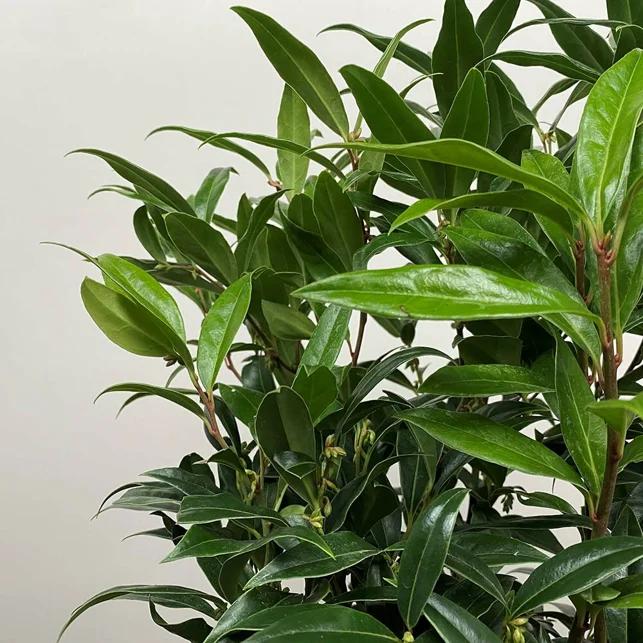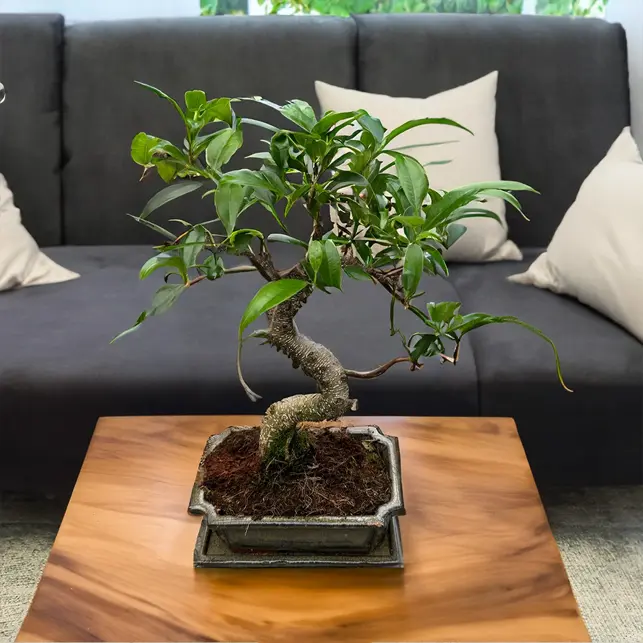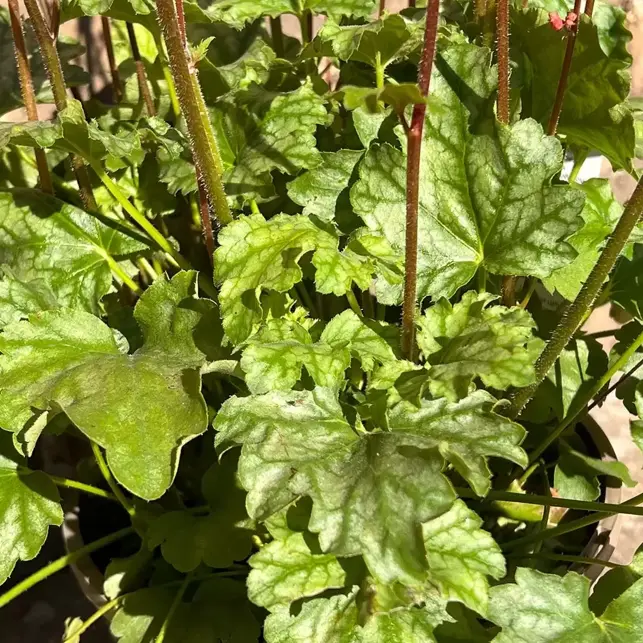
December gardens ask different questions. Light fades by four, frost threatens borders, and that daily walk from gate to front door happens mostly in darkness. This is when fragrance matters most, when a plant that performs without fuss becomes indispensable.
Sarcococca, sweet box, handles London's difficult conditions with quiet competence. Evergreen structure, deep shade tolerance, and an extraordinary winter scent that catches you unaware on cold evenings. These undemanding shrubs provide sensory impact exactly when it's needed.
These Far Eastern natives deliver glossy foliage year-round, but their real value emerges between December and March when tiny, creamy flowers release a honey-vanilla fragrance that travels remarkable distances. Plant near entrances, along paths, or beneath windows, and winter evenings gain an unexpected dimension.
Why December Fragrance Changes Everything
Most winter gardens are visual. Evergreen structure, sculptural stems, perhaps some late colour from winter-flowering shrubs. But scent operates differently. It arrives before you see the source, lingers after you've passed, and transforms mundane journeys into something genuinely pleasant.
Sarcococca excels precisely because it asks nothing. No deadheading, no complex pruning regimes, no special feeding schedules. Plant it properly, step back, and every December onwards it performs. For north-facing terraces or shaded front gardens where little else thrives, sweet box fills gaps both practical and sensory.
The fragrance itself is sophisticated rather than overwhelming. Walk past on a still morning and it's unmistakable. Stand directly over the plant and it's subtle. This balance suits urban spaces where heavy scents can feel intrusive. In terraced streets where neighbours are close and front gardens modest, Sarcococca delivers impact without imposing.
Smart Placement
Entrances That Welcome
A pair of Sarcococca confusa flanking a front door transforms every arrival home between December and March. This reliable variety grows slowly to around a metre, tolerates deep shade, and produces masses of scented flowers without any intervention. For those narrow entrance paths, such as Church Row, Hampstead, typical of period terraces, where sunlight barely reaches, confusa suits both architectural style and difficult growing conditions.
'Winter Gem' brings compact growth and exceptional flowering, ideal where space is limited. Its neat habit works for smaller front gardens or contemporary townhouse entrances where oversized planting feels wrong. The fragrance reaches pavement level, meaning visitors encounter it before they knock.
Courtyard Solutions
Enclosed spaces magnify scent. Courtyards and basement areas, often heavily shaded by surrounding buildings, benefit from Sarcococca shade mastery. 'Fragrant Valley' develops into a broader mound than confusa, making it suitable for filling larger gaps beneath stairs or along boundary walls where structure matters as much as scent.
'Purple Stem' adds winter interest through burgundy-tinted young growth, practical when viewing the garden from kitchen windows during dark months. This variety tolerates the driest shade, useful in ‘Pond Square’ / South Grove’ corners beneath mature trees or alongside Victorian extensions where soil stays permanently parched.
Larger Gardens, Layered Thinking
Where space allows, mass planting of Sarcococca delivers proper ground cover whilst amplifying fragrance. In larger gardens with mature borders, drifts of confusa beneath deciduous shrubs create winter structure when the canopy above is bare. This layering approach maximizes difficult spaces, putting evergreen, scented plants exactly where summer performers have faded.
'Dragon Gate' brings narrower, upright growth for tighter gaps between established plants. Its vertical habit suits formal hedge-fronts or alongside paths where width is restricted but height is welcome. Where planting schemes are already established, this variety slots between existing shrubs without competing aggressively.
For those seeking variety beyond the standard confusa, hookera varieties like 'Purple Gem' offer larger leaves and a slightly different growth pattern, whilst humilis delivers the most compact option, rarely exceeding forty centimetres. This dwarf form suits contemporary planting schemes in roof terraces or balconies where low maintenance and small scale are non-negotiable.
The Varieties Worth Knowing
Confusa remains the go-to variety for most situations. Glossy foliage, reliable flowering, tolerates neglect, and suits everything from pots to borders. Available in multiple sizes, it's the sweet box that simply works without demanding specific conditions.
Winter Gem combines compact size with prolific flowers, particularly valuable where space is tight. Its controlled growth makes it suitable for containers or small front gardens where proportion matters.
Fragrant Valley develops into a broader shrub, useful for filling larger spaces or creating informal hedging. The scent is particularly strong, and the plant tolerates deeper shade than most alternatives.
Purple Stem adds subtle colour through burgundy young growth, providing extra winter interest alongside the fragrance. Handles the driest conditions, making it ideal for problem spots where other plants struggle.
Dragon Gate offers narrow, upright growth, practical for squeezing into established borders or alongside paths. The foliage is slightly darker, creating useful contrast.
Humilis remains the compact specialist, perfect for pots, edges, or contemporary schemes where height restrictions apply. Despite its small stature, the fragrance is disproportionately powerful.
Making Sarcococca Thrive
Sweet box wants well-drained soil enriched with organic matter, but tolerates heavy London clay better than many shrubs. Work in compost before planting, ensure the root ball sits level with surrounding soil, and water well initially. After establishment, Sarcococca manages independently.
Shade suits it perfectly. Full sun is tolerated but unnecessary, making these shrubs ideal for north-facing aspects, beneath trees, or alongside buildings where light barely reaches. The glossy foliage stays pristine year-round without scorching or fading.
Pruning is minimal. Remove any wayward stems after flowering if the shape needs correction, but generally Sarcococca maintains itself. No deadheading required, no special winter protection, no feeding regimes beyond an annual mulch of compost.
For containers, use John Innes No. 3 mixed with additional organic matter. Water during establishment, then only during prolonged summer drought. These are genuinely low-maintenance shrubs that perform decade after decade without fuss.
By late February, flowering finishes and small black berries develop. These add minor ornamental value but the real work is done. From March onwards, Sarcococca provides an evergreen backdrop whilst other plants take centre stage, ready to repeat the performance next December.
Why Sarcococca Works in North London
Urban conditions suit sweet box surprisingly well. Pollution tolerance, shade adaptation, and the ability to thrive in problematic soil make these shrubs practical choices for challenging city gardens. They persist through winter without losing foliage quality, maintaining structure when everything else looks tired.
The compact growth habit means Sarcococca fits smaller spaces without overwhelming, whilst the fragrance provides sensory value disproportionate to the plant's physical size. For balconies, courtyards, basement areas, or narrow side passages, this combination of traits is difficult to match.
Maintenance requirements are genuinely minimal. Plant properly, mulch occasionally, and Sarcococca delivers year after year. For time-poor Londoners wanting winter impact without weekend gardening commitments, sweet box represents a pragmatic solution.
Reference Table: Sarcococca Care and Value
| Feature | Details |
|---|---|
| Winter Care | Plant in well-drained soil with organic matter, minimal intervention required, occasional mulch beneficial |
| Flowering Period | December to February, tiny creamy-white flowers with strong honey-vanilla scent |
| Foliage | Evergreen, glossy, dark green (some varieties with purple tints), maintains quality year-round |
| Growth Habit | Slow-growing, compact to medium shrubs, 40cm-120cm depending on variety |
| Good Locations | Entrances, paths, courtyards, beneath windows, under trees, north-facing aspects, containers |
| Shade Tolerance | Excels in shade, tolerates deep shade where most shrubs fail, full sun acceptable |
| Varieties | Confusa, Winter Gem, Fragrant Valley, Purple Stem, Dragon Gate, Humilis, Purple Gem |
| Key Problems | Avoid waterlogged soil, otherwise trouble-free, no significant pests or diseases |
| Year-round Benefit | Evergreen structure, winter fragrance, minimal maintenance, long-lived, tolerates urban pollution |
Talk to the horti team
Visit Boma on a weekday when there's time for proper conversation about what suits where. The team knows which varieties handle specific conditions, which combinations work, which promises are realistic versus aspirational.
Stock ranges from smaller 2L plants through to established specimens ready for immediate impact. The smaller ones establish quickly and often overtake rushed larger plantings within two seasons. The bigger ones suit filling gaps or creating instant presence.
For scented combinations near entrances, we've already considered what works: Sarcococca with winter-flowering Viburnum, or sweet box alongside early hellebores for extended seasonal interest. Practical pairings that deliver results rather than catalogue fantasies.
Summary and Key Takeaways
The best winter gardens combine structure with sensory value. Sarcococca manages both without demanding attention, which between December and February feels exactly right. Plant it near where you walk regularly, and those dark winter evenings gain unexpected pleasure.
Shop our full range of Sarcococca varieties, evergreen shrubs, and winter-flowering plants online. Boma offers both expert knowledge and hands-on planting services to create gardens that work throughout the year, from initial planning to final planting.
Get in touch or visit us in Kentish Town to explore everything winter gardening has to offer.







